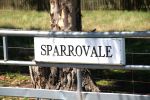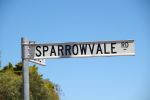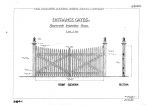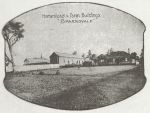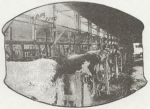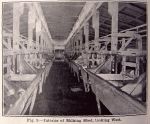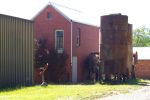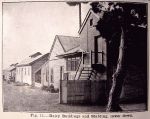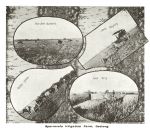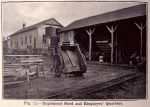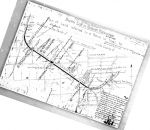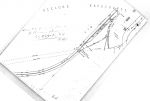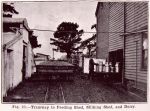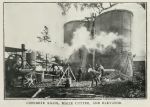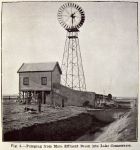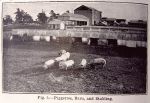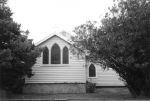 The question that started this search for information ... is it Sparrovale Farm or Sparrowvale Farm?
The question that started this search for information ... is it Sparrovale Farm or Sparrowvale Farm?
The spelling is what sparked an interest in this amazing farm. The farm commenced in the first decade of the 20th century - reasonably modern history - but many people worked on this property and its history is an important part of our local history.
First: this is PRIVATE property - please respect the owners and do not invade their territory!
|
The question was asked back in early 2010 - what is the correct spelling? The sign on the gate is quite clear - Sparrovale. The street post sign is also quite clear - Sparrowvale Road. The plan produced for the Geelong Harbor Trust Commissioners of the entrance gates for the Sparrovale Irrigation Farm is also quite clear. It is understandable how the confusion arose:
There is no question based on official contemporary reports that the correct spelling is SPARROVALE. And before anyone questions the spelling of the Geelong Harbor Trust - this is also the correct spelling ... it is not Harbour! |
|
|
1908 Source: Illustrated Guide: Geelong and District, issued by the Committee of the Geelong Progress Association, facsimile copy of 1908 revised edition [2nd edition], Deakin University Library, Geelong, 1990. This is probably one of the best summaries of the early years of Sparrovale Farm ... Sparrovale Irrigation Farm No mention of the industries of Geelong would be complete without reference to the Sparrovale Irrigation Farm carried out under the auspices of the Geelong Harbor Trust, on the lower reaches of the Barwon, in the Connewarre district. The main entrance to the homestead is at Marshalltown about five miles from Geelong. Portion of the property was originally used as a racecourse, whilst the adjacent lands, with few exceptions, were allowed to lie idle. When the land was handed over to the Harbor Trust Commissioners, they conceived the idea that under proper management what had hitherto been regarded as waste land, was capable of profitable cultivation. With this object in view, no time was lost in draining the land and effecting improvements which bid fair, according to present indications, to make Sparrovale Irrigation Farm one of the most up-to-date and profitable farming ventures in Australasia. Immediately adjoining the residence of the manager (Mr Wm Baird) the nucleus of an extensive nursery has been created, and near this several three-quarter acre blocks have been reserved for the purpose of employees' cottages. A poultry run, calf sheds (subdivided into three pens, to suit varying stages of development), and cattle shelter sheds, are conveniently situated. For the purpose of testing, &c., the cows are kept in lots of fifty, each lot being treated as a separate herd. The dairy buildings are constructed on the latest scientific basis. The lower part of a large two-story brick building [see photo] is used as a refrigerating room, whilst the milk-testing is done upstairs. Every facility is provided for the various branches of dairy work. The milking shed accommodates fifty cows, twenty-five on each side, and arrangements have been made for the necessary extensions. Twelve Hartnett machines are at present in use, driven by a six h.p. engine. Two circular silos, built of concrete on the Monier principle, are capable of holding nearly five hundred tons each. Every effort is being made to have none but the most profitable breeds of stock on the farm, and with this object in view great care has been shown in the initial selection. All the land not required solely for stock purposes is now being channelled on the surface for irrigation, and laid with underground piping every five chains for drainage. The pumping plant, which is erected on a barge moored in the river, can be moved as required. It consists of a one-hundred and thirty h.p. engine and boiler, driving a pump that delivers six thousand gallons per minute. Already the beneficial effects of this procedure are noticeable, and the various crops have more than fulfilled expectations. Sparrovale is proving of a great educational benefit to the farming communities of the State. It gives a concrete example of profitably providing a pure milk supply, and demonstrates the possibilities of scientific agriculture in bringing out the latent potentialities of what has hitherto been looked upon as almost barren land. The farm may be inspected on Wednesday afternoons, and orders to view may be obtained from the office of the Commissioners, Brougham Place. |
|
|
1890 These two maps show the location of the Geelong Racecourse at Marshall - on land which later became Sparrovale Farm. The start of the spur line [dotted lines] is located at Sparrovale Road which runs north-south. The numerous allotments shown to the right of this road were all part of Sparrovale Farm. This spur line was not the only "railway" in use on Sparrovale Farm. A tramway was constructed to aid with the transportation of feed and milk - connecting the feeding shed, milking shed, and the dairy. Marcus Wong's web site - Rail Geelong - includes a page on the Sparrowvale [sic] Tramway. |
|
|
1907 The discovery of a web site by Alan Holgate ended up with "two heads being better than one". I contacted Alan to ask permission to use his text on the Sparrovale silos in this web site. Not only did Alan give permission, but he spurred me on to discover more. I had a poor quality image [top photo] taken at Sparrovale Farm in the collection of the late Ian Wynd. Although the caption read "steam engine" I was convinced that it was the silos described on Alan's web site but there was absolutely no proof. That then led to the search for some sort of proof - date of photograph, more detailed caption etc. References in an article by Jim Ferguson in the Investigator, journal of the Geelong Historical Society provided the link. The poor quality image appeared in this article and the overall references included 1908 and 1913 issues of the Journal of Agriculture, Victoria [sic]. I found the 1908 issue which included the original photo and Alan found the "missing" 1913 issue at the State Library of Victoria [see next section]. And the cream on the cake - Alan rechecked his source material and was able to confirm the references to Sparrovale and not Sparrowvale. It is a fascinating article on an important component of the Sparrovale Irrigation Farm ... John Monash: engineering enterprise prior to WWI Histories of selected tanks and silos, not located, not built, or demolished prior to 2000 Location: Sparrovale Irrigation Farm, Reserve Rd, Marshalltown, nr Geelong. History MacKenzie contacted RCMPC in October 1907 to ask for an initial quote for silos 30 feet high and 20 feet in diameter with no floor or roof. Monash did not expect to compete with other materials on first cost, but stated that "monolithic reinforced concrete work" would provide silos "superior to, and more stable and safer than silos depending largely on the stability of a large number of independent units, more or less efficiently held together by exposed metal bands or hoops". Then followed three months of rambling negotiations during which he declared "With regard to plans and specifications, these would take some time and trouble to prepare, and it seems that the fair course to us would be for you first to indicate whether our price is acceptable to you ... whereupon I would prepare complete documents for a binding contract". In late January he prepared a "final design", with drawing and specification, telling MacKenzie "...I take it for granted that these particulars would not have been called for unless it was your intention to shortly give us an order for the work". The Trust accepted the price of £397, but demanded a 'maintenance period' of 12 months during which RCMPC would bear the cost of fixing any problems which might develop, while the Trust held back 25% of the contract price as a surety. Monash wrote "The several minor amendments of verbiage are concurred in ..." but the major demands ought to have been considered in the tendering process. "The reputation of reinforced concrete, and of the work of this Company, are too well established to need heroic safeguards at this late hour." He pointed out that RCMPC obtained normal terms from Government Departments in Victoria and South Australia, and could get as much work as it cared to undertake. He believed final settlement after a maintenance period of three months, together with a written guarantee for a further nine months should suffice. He noted that this made RCMPC responsible for the whole of the silos for this period, not just for a percentage and emphasised that he had no desire to escape responsibility, but simply wanted normal financial arrangements. The Trust, through MacKenzie, seems to have accepted this arrangement; but after further delay Monash was obliged to write to the Chairman of the Trust, G F Holden, agreeing to yet more minor amendments, and asking "Are we to have a formal contract?" Holden replied that none was deemed necessary. During negotiations, the size of the silos had increased slightly, and floors and roof had been added. Monash had tried to include in the specification a wash of cement grout on the inside of the walls to lessen their permeability, but MacKenzie had insisted this question be deferred until construction was complete. Work commenced late in February or early in March 1908 with J. Shepherd as foreman. Almost immediately, a dispute developed over the measurement of the materials for making concrete, with MacKenzie claiming that RCMPC was using less cement than required by the specification. The issue was clouded by the fact that Australian engineers adopted the British practice of measuring sand, gravel and cement by 'loose volume' (rather than by weight as in European practice). Worse still, cement was measured in 'casks' and there were differences in the number of cubic feet to be expected, depending on manufacturer and region. Monash argued strongly that the proportions in the wet concrete were those required by the specification. He was not worried about a few bags of cement, but about the "imputation that we are not faithfully carrying out our undertakings". Compliance with MacKenzie's demands would lead to excessive shrinkage, but "to avoid small differences becoming embittered" he would defer to MacKenzie's point of view. The latter replied dryly that he was glad Monash would now comply with the specification. However, Monash had the last word, claiming "as one who has considerable experience ... and is considered as somewhat of an authority on the subject, based upon a very large amount of scientific testing" that the concrete would now be weaker than before. During this debate the first silo was completed at the end of March. Monash asked whether the cement wash was required on the interior and was apparently told it would not. In mid-April, preparing to go on military manoeuvres for a week, he left Shepherd with instructions for the completion of the second silo and for tidying up and leaving the site, adding "I think it now unlikely that the Harbor Trust will order the construction of two additional silos". In mid-May MacKenzie wrote to say that the first silo had been half-filled and was leaking and sweating badly. Monash replied that he was taken completely by surprise to learn that the silos were expected to resist water pressure rather than dry silage. He warned against allowing the height of water to exceed ten feet and asserted that the leakage would gradually solve itself. When MacKenzie persisted, he wrote: "...it is not reasonable to expect young concrete to show water-tightness at the outset, and the period which has elapsed between your two letters is insufficient to allow of any noticeable change in the porosity of the concrete ... [As filling continues] the whole shell will become charged with moisture, and wetness will make its appearance over the whole or greater part of the outer surface. This action is not only unavoidable, but is beneficial to the concrete, as it will hasten the chemical action which, in a little while, will make the concrete impervious to further moisture. The same phenomena have been evidenced times out of number in water tanks, pipe lines, syphons etc. built all over the country, which are now absolutely watertight". It took several more letters from MacKenzie before Monash finally sent his Works Manager to examine the tank. Lynch reported to Gibson that where leaks occurred, the concrete was soft and a layer of about six millimetres could be rubbed off easily with a finger. He asked Gibson, an industrial chemist, whether it was the gas generated by the silage which affected the concrete, or the liquid, which contained a large percentage of sugar. He noted that where the shell was dry, the concrete was fair but not specially good, the top edge of the shell being rather soft. He reported to Monash that the silo was now full and contained 300 tons of silage. There were no cracks or distortion in the shell, but innumerable "pin holes". He commented that the silo must be "acting as a tank and may have a head of up to 20 feet in the form of a film of liquid round the inside of the shell". The leakage was aggravated by gas in the tank which escaped with the liquid and made a hissing sound which could be heard at some distance. The ground was getting boggy and a French drain had been constructed. MacKenzie had disagreed that a film could exert hydrostatic pressure, but Lynch had stuck to his guns having heard Monash "so state on several occasions". Although the rate of discharge was beginning to decrease, Lynch promised that if no improvement occurred within three months, by which time the silo would be empty, RCMPC would apply a cement wash to the inside. In the meantime, the behaviour of the second silo, which had been washed on the inside to a height of ten feet, could be studied as it was filled. Monash confidently told MacKenzie that Lynch's report "entirely confirms the view put before you, viz. that there is not the slightest reason to entertain any alarm as to the suitability or strength of the structures, provided they are not given the task of holding liquid to a considerable depth". Late in June, Gibson reported that tests on samples of concrete immersed in sugar solution showed deterioration of the surface similar to that occurring in the silos, and he recommended rendering the interior surface and treating it with a solution of silicate of sodium. In mid-August MacKenzie refused a claim for final payment, stating there were still small holes in the walls. In November, Monash made the following points to Gibson in respect of the claim:
Monash added: "I have found Mr MacKenzie very amiable personally, but quite unreasonable on paper". He suggested Gibson settle the matter with Holden. The record ends with Gibson and Monash arguing energetically that the fault lay in MacKenzie's refusal to have the first silo rendered or lime-washed on the inside as advised, but reluctantly agreeing to perform this work free of charge provided it was not interpreted as an admission of liability, while MacKenzie continued to insist that this should have been included in the initial design. Technical Description. Initial contract for two silos 20 feet (6.10m) internal diameter, 35 feet (10.7m) high, separated by a distance of 23'-8" (7.21m). Roof: corrugated iron sheeting supported by iron trusses covering the intervening space as well as the silos. Walls: 4" (102mm) thick at the bottom and 3" (76mm) thick at the top, with a stiffening ring 6" wide and 9" deep (152 × 229mm). Floor: 6" thick. |
|
|
1908 The Journal of the Department of Agriculture of Victoria Who would have thought that research into the spelling of a name ... Sparrovale ... would lead to some wonderful discoveries? This journal, together with the 1913 issue give wonderful detailed descriptions of Sparrovale Farm together with an amazing collection of photographs. The 1908 volume together with some other years has been digitised and can be viewed online. The 1913 volume is not online but is available with the rest of the collection at the State Library of Victoria. The two extensive articles and photographs on Sparrovale Farm in these volumes are well worth reading in full - far too lengthy to include here but if this web site has whet your appetite, then you will enjoy reading ever more. |
 |
|
c.1906 Pescott, John, South Barwon 1857-1985, City of South Barwon & Neptune Press, 1985, pp.125-6 Sparrovale Farm The [Geelong] racecourse land at Marshall was never sold by the Crown. Instead on July 1 1906 nearly six months after the last race meeting, the land was handed over to the newly formed Geelong Harbour Trust. This land, along with numerous other areas was an endowment to the Trust from the Government. Most of the land obtained in the Connewarre area was prone to flooding. After draining the land and installing an irrigation system, the Geelong Harbour Trust set about establishing a model farm. It was known as the Sparrowvale irrigation farm, named after the popular secretary of the Geelong Racing Club, MR E R Sparrow. Activities on the farm included the raising of cows, pigs, horses, and poultry, and the growing of maize, oats and lucerne. To assist with the transport on the farm, a tramway was constructed. It was of narrow gauge, probably 26 inches laid with light rail (15 lbsyd). It is believed the tramway was worked by a small internal combustion engine. The tramway ran from the milking shed through the creamery to the hay shed. The hay shed, a storage silo, pig sties, stables and calf sheds were connected by tram line and then the rails ran down through the paddocks. When a levee bank was being constructed along the Barwon River the tram was used to move soil. The tramway remained in operation until the 1930's. Despite initial optimism about the viability of the farm, the envisaged financial success was never obtained. Sparrowvale was eventually sold by the Geelong Harbour Trust in 1936 for 10,500 pounds. During 1907, the Geelong Harbour Trust paid 52 pounds, 16 shillings, 6 pence for "ballast removal". Presumably this referred to the dismantling of the portion of the former racecourse railway which lay inside the farm boundary. |
|
|
1936 April Using various articles, buildings and landmarks have been identified. NOTE: many of the buildings no longer exist:
|
|
|
1907 North Eastern Ensign (Benalla, VIC), Friday 20 December 1907, p. 8 (Supp) Hartnett Milking Machines Greatest Invention of the Age. 50 per cent. saved in working expenses. MILKS BY LIGHT SUCTION AND PRESSURE.-THE ONLY NATURAL WAY. Used exclusively at the Government Agricultural College, Dookie, and "Sparrovale" Irrigation Farm, Geelong, in preference to all others. Injury through overmilking impossible. The "Hartnett" is the only Milking Machine fitted with Automatic Releasers, which are the only safeguards against overmilking. Will not dry off the cows. COSTS MUCH LESS IN UPKEEP THAN OTHERS. "PERFECT" Cream Separators Hold the world's record for clean skimming, and have secured the most first awards at all European Competitions for clean skimming and simplicity. Have the largest world-wide sale. Costs practically nothing in upkeep. 98% of all Separators purchased for Danish Creameries during the year 1900 were "PERFECTS." SEAMLESS STEEL CANWARE. Made out of solid steel plate. Everlasting wear. No joints or crevices to harbour Bacteria. Recommended by Government Dairy Experts and Supervisors. Every Description of High-class Farm and Dairy Machinery and Requisites Stocked. Farm & Dairy Machinery Co., 517-519 COLLINS STREET, MELBOURNE |
 |
|
1908 Argus, Friday 21 February 1908, p.6 GEELONG AND DISTRICT. One of the chief places of interest visited by the Ballarat councillors on Wednesday was the Harbour Trust Dairy Farm at Sparrowvale, where a complete scheme of irrigation has been carried out. The water is circulated by means of a steam pump with a capacity of 8,000 gallons per minute, and splendid crops of green food for the herd of 300 milking cows are being grown. In order to provide a constant supply of proper food the commissioners intend erecting two silos each of 300 tons capacity. |
|
|
1908 Argus, Thursday 9 July 1908, p.6 CHAMBER OF AGRICULTURE: DELEGATES AT WORK. GEELONG HOSPITALITY. GEELONG Wednesday - The business of the convention was returned at 9 a.m. this morning. VISIT TO SPARROWVALE FARM Nearly every member of the conference joined the party to Sparrowvale farm this afternoon. Mr Swinburne, the Minister of Agriculture, was also present. This farm was started about a year ago by the Geelong Harbour Trust. It contains about 700 acres and includes the site of the old race-course. Great progress has been made in the short time it has been under the trust's control. During the summer 80 acres were sown with maize and irrigated by a pump on a pontoon in the Barwon. Over 800 tons of ensilage was made from the maize crop and this is stored in two concrete silos holding 400 tons each. About 200 cows were milked in the autumn, and the number now is 150. The milk is sent to Melbourne for the milk supply of the city. Over 100 pigs are kept and all the plans are laid for running an up-to-date dairy farm. The visitors were received by Commissioners Holden and Hill and the farm manager, Mr Baird. Mrs Holden and Mrs Baird provided afternoon tea for the visitors. The president (Mr Fincham) briefly thanked the hosts for their hospitality. In the evening the president and a number of delegates were entertained at dinner by Mr Volum, president of the Geelong Agricultural Society at the Victoria Hotel. At the evening session a lecture on "Un-soundness in Horses" was delivered by Mr S S Cameron, MRCVS This was followed by a lecture on the features of modern European viticulture by Mr F De Castella. Both lectures were illustrated with lantern views, and were highly appreciated. |
|
|
1909 Argus, Friday 29 January 1909, p.5 CROSSING FATALITY. TRAIN SMASHES WAGGONETTE. ONE MAN KILLED, SEVERAL INJURED. GEELONG, Thursday - This morning, at a quarter past 7 o'clock a covered vehicle, which seated six employees of the Sparrovale Farm, managed by the Geelong Harbour Trust, named respectively Robert George Thompson, Little Fyans-street, South Geelong; George Watkins, Fyans-street, South Geelong; John Betts, Pakington-street, Chilwell; John Sullivan, Victoria-terrace, Geelong; William Leighton, Bellerine-street, Geelong and George Smith, Barrabool-road, Highton, was run down by a goods train, which left Geelong at 6.30 am for Colac, at the level crossing at Marshalltown about three miles from Geelong on the Barwon Heads road. All of the occupants of the vehicle which was covered right to the splashboard, the cover completely obstructing any side view, were thrown out, and George Smith was killed on the spot. The men were conversing as the waggonette neared the crossing apparently oblivious of the approach of the train which was in charge of Driver M Drew, Fireman James Laycock, and Guard E A Bragge. An approaching train can be seen some considerable distance on either side of the crossing. The engine struck the vehicle between the two off-side wheels and carried it some 40 yards, shattering it into matchwood and scattering the occupants in all directions but clear of the line. The shafts were broken off by the force of the impact and the horses which had just managed to get across the rails when the train struck the waggonette got away, and galloped off along the road. Leighton, who is a single man, and Betts, who is married, were thrown down an embankment into a ditch, and escaped with slight injuries. After treatment at the hospital they were able to proceed to their homes. Thompson received abrasions to the head and neck, Sullivan a cut on the head and abrasions, Watkins an injured hip and internal injuries. All three have been admitted to the hospital, suffering also from shock. Smith, who was killed, occupied a seat in the rear of the vehicle and he was hurled with great force against one of the fencing posts at the crossing and his head striking the obstruction his brains were dashed out and scattered around. The body of Smith, who was a married man, 52 years of age, with a wife and six children was subsequently brought in to the morgue. |
|
|
1909 Argus, Thursday 8 July 1909, p.8 SPARROVALE IRRIGATION FARM. It might appear from our recent report of the floods at Barwon Flats that the Sparrovale Irrigation Farm had been flooded. Water did spread over portion of the land, as in previous years, but no damage was done to the property or crops. |
|
|
1914 Ashburton Guardian, 26 February 1914, p.7 ITEMS FOR FARMERS. [ ... ] Some excellent yields of lucerne have been obtained from the flats at Sparrowvale Farm, the property of the Geelong Harbour Trust Commissioners. Since December 17, 1913, the return shows an average of 4½ tons green weight per acre. The cut is, in each instance, the third, and the return as follows:- from 20 acres, sown in 1910, 84 tons; 12½ acres, sown in 1912, 87 tons; 29 acres, sown in 1912, 86 tons; 12½ acres, sown in 1912, 70 tons. From the crops sown last year the cuttings were lighter. The supply of lucerne the trust has now in hand, nearly fills the two immense silos, and will, it is estimated, be sufficient to feed the cattle during the winter months. |
|
|
1915 Argus, Monday 15 March 1915, p.11 SPARROVALE FARM ROBBED. SAFE BLOWN OPEN. GEELONG, Saturday. - A daring but successful robbery was perpetrated at Sparrovale farm, the property of the Geelong Harbour Trust commissioners, at Marshalltown, early this morning, when the office was entered, and the door of the safe, which is a very strong one, blown open by placing a charge of gelignite in the keyhole, and the contents, amounting to £84/15/4 in cash, and cheques aggregating £80/7, stolen. Not a trace of the robbers was left, although they might easily have been captured, as they were seen at work by Mr R Maidment, who had charge of the creamery. He came into work at 10 minutes past 4 o'clock in the morning. He noticed a light in the office, and on looking through the window mistook the men for the farm manager, Mr Baird, and the overseer, Mr Barclay. At the time one of the men was on his knees, and the other holding a candle as if in search of something; both had their backs to Mr Maidment, who went about his work as if nothing was wrong. When later on he had occasion to go to the overseer's room for a piece of piping for the machinery, he casually remarked to Mr Barclay that he was up early that morning, and this led to the discovery of the robbery. This was at about 5 o'clock. From the office there is only a space of about 12ft., but although Mr Barclay is a light sleeper he heard nothing of the explosion, which to an extent was softened by placing the safe upon the side covers removed from a hooded buggy. Students sleep about 10 yards away, and the manager's residence is only 30 yards from the office. Payment of the cheques has been stopped. The police were immediately notified and Superintendent Macmanamny sent Detective Mercer down to assist in the inquiries. The robbers missed £8/15/ contained in an envelope left in an office drawer overnight by Mr Baird, also an amount collected for the Belgian Relief Fund on Friday, and placed in the desk. Maidment states that one of the robbers was an elderly man, and the other had particularly black hair and was somewhat thick set. |
|
|
1920 Argus, 17 March 1920, p.6 SOLDIER SETTLEMENT. Proposals for making an area of land at Geelong, now under the control of the Geelong Harbour Trust, available for soldier settlement purposes are to be placed before the State Cabinet by the Assistant Minister for Lands (Mr Mackinnon). Accompanied by the chairman of the Water Supply Commission (Mr Cattanach), Mr Mackinnon visited Geelong on Friday and inspected a considerable area of land, including Sparrowvale Farm, about which there has been considerable controversy. Mr Mackinnon is satisfied that if the waters of the Barwon River at high flood can be kept off the low-lying land as they are now kept off Sparrowvale Farm, there is room for the settlement thereon of 50 or 60 families. That project would involve a certain amount of reclamation work. |
|
|
1921 Argus, 13 October 1921, p.8 GEELONG HARBOUR TRUST: ADMINISTRATION CRITICISED - Unsatisfactory Finances. Criticism of the conduct of the affairs of the Geelong Harbour Trust is contained in the report of the Committee of Public Accounts, which has been presented to the State Parliament. The committee said that, in his reports to Parliament for the years 1919 and 1920, Mr J A Norris, auditor-general, had directed attention to the unsatisfactory position of the finances of the Geelong Harbour Trust, and to its increasing indebtedness to the Ministry, through the trust failing to pay the Treasury the interest due half yearly on moneys borrowed from the State. On December 31, 1920, the arrears of interest were £75,652. The Ministry had not received any interest on these loans since 1915. The inquiry revealed that the trust had been too optimistic from the outset as to the results that would accrue from its expenditure of loan moneys, particularly on Corio Freezing Works and Sparrowvale farm. The Committee of Public Accounts recommended, among other matters, that the trust should be reconstituted by the appointment of a practical business man as chairman, who should receive a salary of £800 a year, on the condition that he gave his whole attention to the management of the affairs of the trust. Two members, one of whom was to be the chief engineer for ports and harbours, should be appointed to be consulted by the chairman from time to time. The debt owing to the Treasury by the trust up to December 31, 1921, as arrears of interest on loan moneys, should be written off. As the renewal of dredging operations in Geelong Harbour was an urgent work, advances up to a maximum of £50,000 should be made by the Treasury to the trust from time to time during the next three years or so to deepen Wilson's Spit Channel, and clean up Hopetoun Channel, to a depth of 29ft. at low water. The trust should receive a yearly contribution of £20,000 for five years from the Ministry out of the moneys paid to the consolidated revenue of the State by the Melbourne Harbour Trust. Sparrowvale Farm and other low-lying lands adjacent to the Barwon River, vested in or belonging to the trust, should be transferred at a price to be arranged to the State Rivers and Water Supply Commission for closer irrigable settlement, returned soldiers being given preference. The proceeds from the sale or transfer of these lands should be paid into a trust account in the Treasury for the redemption of the trust's debentures. The gift by the trust of Osborne House, furniture, and 28 acres, to the Naval authorities as a submarine base, should not be ratified by Parliament. Parliament should consider the question of leasing this property to the Defence department. The new trust should look into the practicability of obtaining additional revenue from steamers regularly using Moorabool street wharf; also from wharfage rates on goods unshipped at Geelong, and of coming to an agreement with the Victorian Railways Commissioners to raise their special low district rates between Melbourne and Geelong by an amount equal to any increase in wharfage rates at Geelong on goods unshipped there from Melbourne or shipped at Geelong for unshipment at Melbourne, thereby maintaining the present ration between ship and railway charges. The Minister for Public Works (Mr Clarke) will visit Geelong on October 25, and in an address to the councillors, Harbour Trust Commissioners, and representative business people, will explain the scheme for the creation of one port authority. |
|
|
1923 Argus, 2 August 1923, p.5 GEELONG HARBOUR TRUST: DEFICIT NOW £70,030/9/9 - Authorised Liabilities Exceeded. Accounts of the Geelong Harbour Trust Commissioners' operations for the year ended December 31, 1922, have been tabled in the Legislative Assembly. Receipts from wharfage, tonnage, and berth rates, grazing fees and other items amounted to £28,982. The amount received from the sale of produce from the Sparrovale farm was £4,663. The Corio freezing works and abattoirs returned £13,344 in the general balance-sheet it is shown that the sum of £53,360 was expended by the Ministry under the items "purchase of dredge and appliances" and "towards dredging Hopetoun Channel." Sundry creditors account for £117,611, and there is a debit balance of £10,756 in the Commonwealth Bank trust fund. The assets include: - Floating plant, £38,138; piers £[?]9,158, Corio Quay, £157,063; freezing works and abattoirs £206,847; and sundry debtors, £4,521. The revenue account debit balance stands at £70,030. General management and maintenance absorbed £24,159. The purchase of feed and materials for Sparrovale farm and the manager's proportion of receipts accounted for £3,398/6/4. Rates, fire insurance premiums and materials for the Corio freezing works and abattoirs £3,304/14/1. The sinking fund account stands at £29,378/12/2. In his report on the accounts the Auditor-General (Mr J A Norris) takes exception to the allocation of the expenditure and to the fact that the Trust has incurred liabilities in excess of statutory authority. He says that no provision is being made for depreciation. A considerable sum is owing to the Trust by the farm manager and attention had been directed to this fact previously. It was unsatisfactory to observe that the amount was increased last year. Immediate steps should be taken to place the arrangements on a sound basis. |
|
|
1927 Argus, 24 September 1927, p.23 SPARROWVALE AYRSHIRE HERD. On behalf of the Geelong Harbour Trust Commissioners, Adamson, Strettle, and Co Pty Ltd. and Dennys, Lascelles Limited will sell the Ayrshire herd on Sparrowvale farm, which is five miles from Geelong on the Barwon Heads road. The herd includes 120 pure registered stud cows and heifers, 25 pure registered stud bulls, 100 grade cows and heifers, and 60 grade Ayrshire heifers. The herd, which was founded 20 years ago, has included and includes many animals which have been awarded championship prizes at the Royal Show. The sale will begin at half-past 10 o'clock. |
|
|
1927 Argus, 30 September 1927, p.16 SPARROWVALE STUD HERD: High Prices Realised. GEELONG, Thursday. - Owing to the decision of the Geelong Harbour Trust commissioners to lease the trust's farm, known as Sparrowvale, on the banks of the Barwon River at Marshall, the trust's herd of 120 pure registered stud cows and heifers, 25 pure registered stud bulls (all Ayrshires), 100 grade cows and heifers, and 60 Ayrshire heifers (9 months to 2½ years old), was disposed of by public auction at the farm today. The herd was established by the original commissioners of the trust soon after the trust was constituted, and for 20 years the herd has been built up from Gowrie Park blood stock. At frequent Royal Shows the stock was exhibited and gained many successes. All the stock offered had been tuberculin tested in the Government test 1926-27. The sale was conducted by Dennys, Lascelles Ltd., Geelong, and Adamson, Strettle, and Co Pty Ltd, Melbourne, in conjunction. The attendance of buyers from all parts of the State was the largest ever seen at a sale in this district. The condition of the stock and the manner in which they were submitted spoke volumes for the carrying capacity of the farm, which is now to be leased for a term of not less than three years or more than 10 years. The area of the farm is more than 1,000 acres. There was keen competition for all classes, and an entire clearance was effected at satisfactory prices. The stud cows sold up to 108 guineas, which was paid by Mr J S Black, of Noorat, for Boronia of Sparrovale, born August 28, 1919. This cow was first prize two-year-old heifer in milk at the Royal Show, 1921; third prize three-year-old, 1922; second prize type and utility, 250lb. standard, 1924; first prize four-year-old type and ability, 200lb. standard, 1925; and was 12th in order of merit in the 1924-25 Government test. Hygeia of Sparrovale, born 28/8/19, with a 392.68 butter-fat test in 1926, was sold at 51 guineas. Sparrovale Echo, 16/10/23, with many Royal Show prizes to her credit, realised 68 guineas. Other prices ranged down to 31 guineas. The highest priced bull was 37 guineas, for Hot Stuff of Sparrovale, 14/11/22. Others sold down to 29 guineas. Hot Stuff of Sparrovale was purchased by Mr W Caley, of Werribee. Grade cows sold from 10 guineas to 17 guineas, with other cattle in proportion. |
|
|
c.1930s Pescott, John, South Barwon 1857-1985, City of South Barwon & Neptune Press, 1985, p.121 Sparrovale Farm In the early 1930's the Church of England services were held monthly in the Mt Colite Hall [Barwon Heads] and were sparsely attended. A building was brought from Sparrowvale to the present site in Hitchcock Avenue. In 1952 the new sanctuary was built [ ... ] Gradually additions were built, furnishing bought and in 1964 Archdeacon Blake dedicated the stained glass windows, lych gate and bell tower, all donated to the Church. City of Greater Geelong Outer Area Heritage Study It was in the 1920s that action was taken to provide an Anglican Church in Barwon Heads, which was at the time meeting in the (former) Mt Colite Public Hall. With the arrival of the Reverend D.D. Carruthers to the Marshall Parish in 1935 came a major development in building the church. 'On one of his visits to Sparrovale Farm at Marshall, the home of his friend Mr Stradbroke Fowler, he saw the possibility afforded by Mr Fowler's wondering what to do with his old woolshed, now that the farm was going over to dairying, and the next meeting agreed that Mr Carruthers purchase the building for £105. This woolshed (which may have been a dining room or men's quarters instead) was moved to the Barwon Heads site soon after, where it was left for some months and only used for the odd meeting. Much of the early restructuring of the Sparrovale building into a Church was carried out by the local builder, Harold Leach. He arranged for his men to use any spare time they had between other jobs on reconstructing the building. They constructed a porch, introduced ventilation, remodelled the windows into Gothic pointed arches, lined the room with masonite and remodelled the west end into an alter. On 24 December, 1937, the Church was in use.
|
|
|
1936 Argus, Friday 13 November 1936, p.5 SPARROVALE FARM SALE GEELONG Thursday - The Lands Department which assumed control of Sparrovale Farm at Marshall on the reconstruction of the Geelong Harbour Trust three years ago, has decided again to endeavour to dispose of the property. A sale will be conducted at the Geelong Lands Office by the lands officer (Mr A L Reah) with Mr W M Read as auctioneer on December 9. The area of the farm is 1,077 acres, and it has an eight-roomed weatherboard house. The upset price is £10,500. On the property are two workmen's cottages and the purchaser will have the option of purchasing them at £300, or, failing their purchase, the Geelong Harbour Trust will be required to remove them within three months. Possession will be given on February 1 next. |
|
|
1936 Argus, Thursday 10 December 1936, p.7 SPARROVALE FARM SOLD FOR £10,500 - Less Than £10 an Acre GEELONG.- Sparrovale Farm, a Crown grant as an endowment to the Geelong Harbour Trust when the trust was formed in 1906, was sold at a Government land sale today for £10,500 to Mr W H Bailey, of Woodside, Buangor. The farm has an area of 1,077 acres on the banks of the Barwon River at Marshall, about four miles from Geelong. Its operation by the Harbour Trust was always subject to criticism, and when the trust was reconditioned in October, 1933, the new commissioners decided to divest the trust of the farm and other lands holding that they did not come within the province of a port authority. The farm therefore reverted to the Lands Department, but continued as an asset in the Geelong Harbour Trust's accounts, and in the last year's balance-sheet was shown at £50,000, including buildings and machinery. This indicates that the trust will be credited with the amount realised for the farm. The improvements include a substantial residence, but certain buildings on the property will be, removed unless taken over by the purchaser. Mr Bailey will take possession on February 1. The sale was conducted by Mr A L Reah, lands officer, and Mr W M Reid was the auctioneer. |
|
|
1943 Argus, Wednesday 20 October 1943, p.3 OBITUARY. MR STEVE BAILEY Mr Steve E Bailey, 75, Suma Park, Queenscliff, died at Newtown, Geelong, on Monday night. Born at Egerton, near Ballarat, Mr Bailey was educated at the Geelong Grammar School, where he took a leading part in all school activities. After leaving school he did a course of engineering at Newcastle on Tyne, and on returning to Australia engaged in grazing pursuits in Western New South Wales and later assumed control of Terrinallum, Mortlake. Mr Bailey was a member of the Geelong Racing Club, Camperdown Racing Club, VRA, MVRC, and the Royal Melbourne Golf Club. He raced several horses, chief of which were Shadow King and Gay Star. He served in the Mortlake Shire Council for about 20 years, and was president several times. Mr Bailey is survived by a widow, one son, Mr W S Bailey, of Sparrovale, Marshall, and Mrs D Payne, of Queenscliff and Geelong. The funeral will take place at the Ballarat Old Cemetery this afternoon at 3. |
|
|
1944 Argus, Thursday 2 March 1944, p.9 SALE OF BLOODSTOCK AT SPARROVALE GEELONG, Wed: A clearing sale of bloodstock was conducted at Sparrovale this afternoon by N Belcher and Co and Wilson, Bolton, and Co, in conjunction, under instructions from trustees in the estate of the late Stephen Bailey, and in partnership with Mr W H Bailey, and also on account of Mr W H Bailey. Top price paid was for Much to Say, a brown mare, bought by Mr McMeekin, of Geelong, for 205 guineas. Patricia Lorraine, a brown mare, went to Mr P M Darcy, of Birregurra, for 67 guineas. |
|
|
1955 Argus, Saturday 24 September 1955, p.16 PROPERTY: Farm sold for £70,000 The property, "Sparrow vale," on the Barwon Heads road, four miles from Geelong, comprising 1,400 acres of Barwon River flats, has been sold for about £70,000. "Sparrowvale" was Geelong's first racecourse, and later was the State Agricultural College. It was made one of the most highly developed farms in the State. The sale was made by McGregor Anthony and Co to Mr C O Lorimer, of "Remirol Park," Ocean Grove, who will move his Red Poll stud to "Sparrowvale," where he plans to establish a dairy herd of over 1,000 head. |
|
|
Edward Rogers "Ned" SPARROW gave his name to Sparrovale Farm. He was a popular Secretary of the Geelong Racing Club and President in 1905-06 prior to the racecourse land being returned to the government and handed over to the Geelong Harbor Trust. He married Anne Maria WILSON, daughter of racing identity James WILSON of St Albans stud. |
Who was E R SPARROW? |
|
Without doubt there is much more to be found on Sparrovale Irrigation Farm - the archives of the Geelong Harbor Trust at the Geelong Heritage Centre would be a good source of further information, however there comes a time when you just have to say "enough"! One thing for certain ... it's definitely Sparrovale! |

